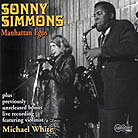October 2000
Simmons was a rising star in avant-garde jazz in the mid-to-late 1960s, and he played briefly with both Eric Dolphy and Charles Mingus before opting out of the recording industry for almost 20 years due to a variety of family and economic problems. He’s been back on the recording scene since the mid-‘90s, and this reissue should go a long way toward restoring his reputation. Arhoolie should be commended for reissuing this music: The first part, recorded in 1969, is one of Simmons’ master works (it received a five-star rating from the All Music Guide to Jazz), and the second, a 1970 concert recording has never seen the light of day until now, offers a peek at Simmons at his creative peak in a live setting. Simmons is joined on the first half of this disc by his (then) wife Barbara Donald on trumpet, Juma on bass, and Paul Smith on drums; on the second half he's in a live performance with violinist Michael White, bassist Eddie Marshall and drummer Kenny Jenkins. Manhattan Egos opens with a burning performance of "Coltrane In Paradise" that, after a brief statement of the theme, plunges into an all-out assault on any and every permeation of said theme. The interplay between Simmons and Donald is a joy to hear. Both take the music in a different direction, yet each is listening to and responding to the other. One of my favorite tracks on Manhattan Egos is "Seven Dances Of Salome," during which the group is joined by Voodoo Bembe on conga drums, and Simmons switches to English horn (and chant). There is an exotic, Middle Eastern flavor to this tune that conjures up visions of the Arabian Nights tales. The concert with violinist White would be of interest, even if the playing were not of the quality that it is, just for the opportunity to hear a violin used in avant-garde jazz. Fortunately, the music is as passionate as the earlier session. White’s violin offers an interesting alternative voice to that of Simmons' alto sax. Listen, for example, to the two on the cut "Purple Rays." White’s long-bowed lines join with, yet still show in stark contrast to, Simmons’ alto. Sonically, this disc is a mixed bag. The first five tracks, those recorded in studio and first released under the title Manhattan Egos, sound fine. The sax and trumpet have edge and bite to them, and the drums and bass set a firm foundation for the music while never overpowering it. The music seethes with passion, feeling and wild abandon. Unfortunately, on the live tracks, the sound, while being somewhat better than bootleg quality, is still of a lesser standard than the studio tracks, with the bass tending to be far too prominent in the mix -- to the detriment of the overall sound. While this doesn’t get in the way of the music, it is still a little off-putting. While Manhattan Egos will never turn me away from my bebop roots, it is a disc I will listen to again, if only to hear the passion that Sonny Simmons felt and put into his music. If you are a lover of the avant-garde jazz movement, Manhattan Egos is worth owning. If you’re not, the collection offers a very good example of the avant-garde style and is a wonderful introduction to it. GO BACK TO: |
 Sonny Simmons - Manhattan Egos
Sonny Simmons - Manhattan Egos![[Reviewed on CD]](../format/regcd.gif) For a
jazz listener weaned on Miles Davis' Kind Of Blue, Sonny Simmons’ Manhattan
Egos comes as the musical equivalent of culture shock. Alto saxophonist Simmons
stretches the limit of melody and harmony while still allowing those unfamiliar with
avant-garde playing to be able to follow and enjoy his musical presentation. I was totally
unprepared for the depth of feeling and passion displayed here. Manhattan Egos requires
a radical change in listening habits to comprehend its message. It’s worth the
effort, though, as the collection hits its musical mark dead center -- the album brims
over with passionate playing.
For a
jazz listener weaned on Miles Davis' Kind Of Blue, Sonny Simmons’ Manhattan
Egos comes as the musical equivalent of culture shock. Alto saxophonist Simmons
stretches the limit of melody and harmony while still allowing those unfamiliar with
avant-garde playing to be able to follow and enjoy his musical presentation. I was totally
unprepared for the depth of feeling and passion displayed here. Manhattan Egos requires
a radical change in listening habits to comprehend its message. It’s worth the
effort, though, as the collection hits its musical mark dead center -- the album brims
over with passionate playing.